Wagner SprayTech 770 User Manual

Owner’s Manual Français - p. 25
Español - p. 49
Contents
Before You Start
2 Important Safety Information
4What’s in the Box
5Assemble Your Wagner Paint Crew
Using the Wagner Paint Crew
6Proper Use and Functions
7Pressure Relief Procedure
8Load Material
9Getting Material to Flow Prior to Spraying
10Practice Spraying
Tips if Experiencing Spray Issues
12Common Solutions to Spraying Issues
13Clear the Spray Tip
14Clean the Inlet Filter
15Clean the Spray Gun Filter
Cleanup and Storage
16Shut Down and Short Term Storage
17Startup From Short Term Storage
18Flush Material from Sprayer
19Clean the Hopper
20Clean Spray Gun Components
21Long Term Storage
Troubleshooting
22 Fix Spraying Problems
24 Replacing Outlet Valve
24 Cleaning or Replacing Inlet Valve
Parts List
74Parts and Accessories for Your Paint Crew
Warranty
75 Limited Warranty for Your Paint Crew
0708 • Form No. 0504945A
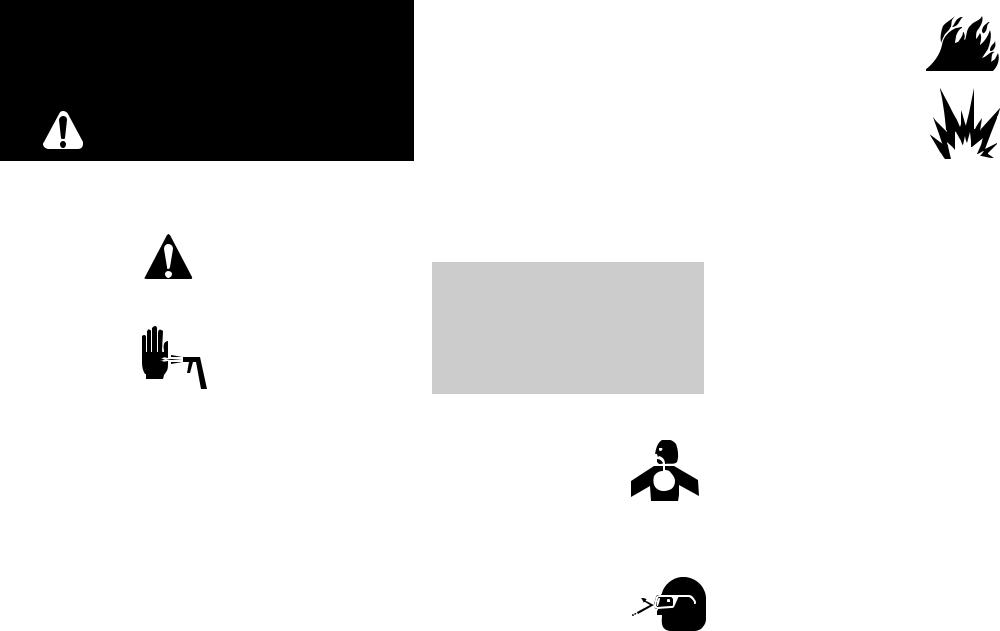
Before You Start
Important Safety
Information
Read all safety information before operating the
equipment. Save these instructions
To reduce the risks of fire or explosion, electrical shock and the injury to persons, read and understand all instructions included in this manual. Be familiar with the controls and proper usage of the equipment.
Indicates a hazardous situation which, if not avoided, could result in death or serious injury.
HAZARD: Injection injury
A high pressure paint stream produced by this equipment can pierce the skin and underlying tissues, leading to serious
injury and possible amputation. See a physician immediately.
DO NOT TREAT AN INJECTION INJURY AS A SIMPLE CUT! Injection can lead to amputation. See a physician immediately.
The maximum operating range of the gun is 2800
PSI/193 BAR fluid pressure.
PREVENTION:
•NEVER aim the gun at any part of the body.
•Do not aim the gun at, or spray any person or animal.
•NEVER allow any part of the body to touch the fluid stream. DO NOT allow body to touch a leak in the fluid hose.
•NEVER put your hand in front of the gun. Gloves will not provide protection against an injection injury.
•ALWAYS lock the gun trigger, shut the pump off, and release all pressure before servicing, cleaning the tip or guard, changing tip, or leaving unattended.
Pressure will not be released by turning off the motor. The PRIME/SPRAY knob must be turned
to PRIME to relieve the pressure. Refer to the Pressure Relief Procedure (page 7) described in the pump manual.
•ALWAYS keep the tip guard in place while spraying.
The tip guard provides some protection but is mainly a warning device.
•ALWAYS remove the spray tip before flushing or cleaning the system.
•Paint hose can develop leaks from wear, kinking and abuse.Aleak can inject material into the skin.
Inspect the hose before each use. Do not use hose to lift or pull equipment.
•NEVER use a spray gun without a working trigger lock and trigger guard in place.
•All accessories must be rated at or above 2800 PSI/193 BAR. This includes spray tips, guns, extensions, and hose.
NOTE TO PHYSICIAN:
Injection into the skin is a traumatic injury. It is important to treat the injury as soon as possible.
DO NOT delay treatment to research toxicity.
Toxicity is a concern with some coatings injected directly into the blood stream. Consultation with a plastic surgeon or reconstructive hand surgeon may be advisable.
HAZARD: HAZARDOUS VAPORS
Paints, solvents, insecticides, and other materials can be harmful if inhaled or come in
contact with the body. Vapors can cause severe nausea, fainting, or poisoning.
PREVENTION:
•Use a respirator or mask if vapors can be inhaled. Read all instructions supplied with the mask to be sure it will provide the necessary protection.
•Wear protective eye wear.
•Wear protective clothing as required
by coating manufacturer.
HAZARD: EXPLOSION OR FIRE
Solvent and paint fumes can explode or ignite. Property damage and/or severe injury can occur.
PREVENTION:
•Provide extensive exhaust and fresh air introduction to keep the air within the spray area free from accumulation of flammable vapors. Solvent and paint fumes can explode or ignite.
•Do not spray in a confined area.
•Avoid all ignition sources such as static electric sparks, open flames, pilot lights, electrical appliances, and hot objects. Connecting or disconnecting power cords or working light switches can make sparks. Paint or solvent flowing through the equipment is able to result in static electricity.
•Do not smoke in spray area.
•Fire extinguisher must be present and in good working order.
•Place paint pump in a well-ventilated area away from the spray object. Flammable vapors are often heavier than air. Floor area must be extremely well ventilated.
•The equipment and objects in and around the spray area must be properly grounded to prevent static sparks.
•Keep area clean and free of paint or solvent containers, rags and other flammable materials.
•Use only conductive or grounded high pressure fluid hose. Gun must be grounded through hose connections.
•Power cord must be connected to a grounded circuit.
•Always flush unit into a separate metal container, at low pump pressure, with spray tip removed. Hold gun firmly against side of container to ground container and prevent static sparks.
•Follow the material and solvent manufacturer’s warnings and instructions. Know the contents of the paints and solvents being sprayed. Read all Material Safety Data Sheets (MSDS) and container labels provided with the paints and solvents. Follow the paint and solvent manufacturer’s safety instructions.
2 |
Before You Start • Important Safety Information |
|
English |
||
|
|
|
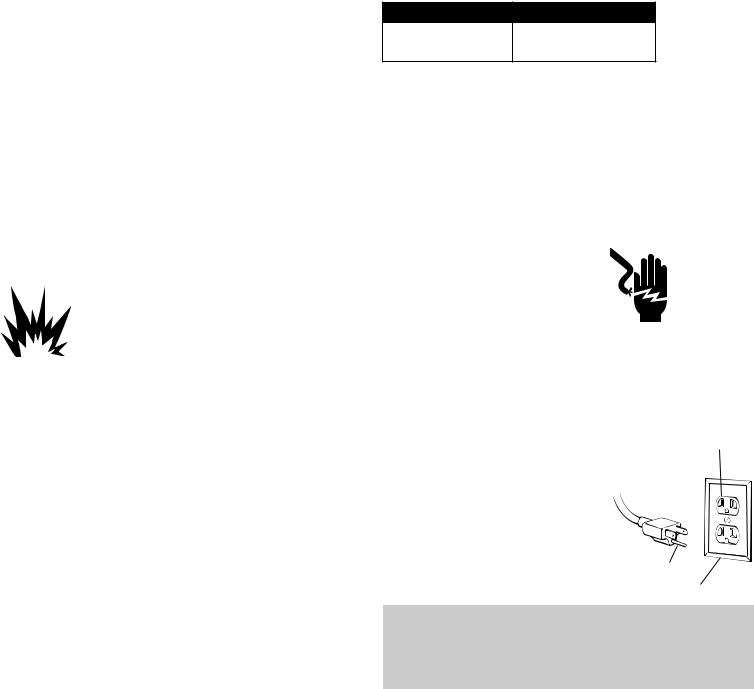
•This product may be used only with water-based materials or materials with a minimum flash point of
70ºF (21ºC) for spraying or cleaning. Do not spray or clean with materials having a flash point less than 70ºF (21ºC), such as solvent based lacquers, enamels, and/or stain blockers. Flash point is the temperature at which a fluid can produce enough vapors to ignite.
•Plastic can cause static sparks. Never hang plastic to enclose a spray area. Do not use plastic drop cloths when spraying flammable materials.
•Use lowest possible pressure to flush equipment.
•Do not spray onto pump assembly.
HAZARD: EXPLOSION HAZARD DUE TO INCOMPATIBLE MATERIALS
Will cause property damage or severe injury.
PREVENTION:
•Do not use materials containing bleach or chlorine.
•Do not use halogenated hydrocarbon solvents such as bleach, mildewcide, methylene chloride and 1,1,1 - trichloroethane.
They are not compatible with aluminum.
•Contact your coating supplier about the compatibility of material with aluminum.
HAZARD: GENERAL
Can cause severe injury or property damage.
PREVENTION:
•Read all instructions and safety precautions before operating equipment.
•Follow all appropriate local, state, and national codes governing ventilation, fire prevention, and operation.
•The United States Government Safety Standards have been adopted under the Occupational
Safety and HealthAct (OSHA). These standards, particularly part 1910 of the General Standards and part 1926 of the Construction Standards should be consulted.
•Use only manufacturer authorized parts. User assumes all risks and liabilities when using parts
that do not meet the minimum specifications and safety requirements of the pump manufacturer.
•Before each use, check all hoses for cuts, leaks, abrasion or bulging of cover. Check for damage or movement of couplings. Immediately replace the hose if any of these conditions exist. Never repair a paint hose. Replace it with another grounded highpressure hose.
•All hoses and fittings must be secured before operating spray pump. Unsecured parts can eject at great force or leak a high pressure fluid stream causing severe injury.
•All hoses, swivels, guns, and accessories must be pressure rated at or above 2800 PSI/193 BAR.
•Do not spray outdoors on windy days.
•Wear clothing to keep paint off skin and hair.
•Do not operate or spray near children. Keep children away from the equipment at all times.
•Do not overreach or stand on an unstable support. Keep effective footing and balance at all times.
•Stay alert and watch what you are doing.
•Do not operate the unit when fatigued or under the influence of drugs or alcohol.
Important Electrical Information NOTICE
Use only a 3-wire extension cord that has a 3-blade grounding plug and a 3-slot receptacle that will accept the plug on the product. Make sure your extension cord is in good condition. When using an extension cord, be sure to use one heavy enough to carry the current your product will draw. An undersized cord will cause a drop in line voltage resulting in loss of power and overheating. A 14 or 12 gauge cord is recommended (see chart). If an extension cord is to be used outdoors, it must be marked with the suffix W-Aafter the cord type designation. For example, a designation of SJTW-Awould indicate that the cord would be appropriate for outdoor use.
Wagner Spray Tech accessory extension cords recommended:
P/N 0090241 20 foot extension cord. P/N 0090242 35 foot extension cord.
|
Before You Start |
|
|
|
|
Cord gauge |
Maximum cord length |
|
12 |
150 feet |
|
14 |
100 feet |
|
Do not use more than 50 feet of spray hose. If you need to spray further than 50 feet from your power source, use more extension cord, not more spray hose.
Grounding Instructions
This product must be grounded. In the event of an electrical short circuit, grounding reduces the risk of electric shock by providing an escape wire for the electric current. This product is equipped with a cord having a grounding wire with an appropriate grounding plug. The plug must be plugged into an outlet that is properly installed and grounded in accordance with all local codes and ordinances.
warning - Improper installation of the grounding plug can result in a risk of electric shock.
If repair or replacement of the cord or plug is necessary, do not connect the green
grounding wire to either flat blade terminal. The wire with insulation having a green outer surface with or without yellow stripes is the grounding wire and must be connected to the grounding pin.
Check with a qualified electrician or serviceman if the grounding instructions are not completely understood,
or if you are in doubt as to whether the product is Grounded outlet properly grounded. Do not modify the plug provided.
If the plug will not fit the outlet, have the proper outlet installed by a qualified electrician.
This product is for use on a nominal 120 volt |
|
circuit and has a grounding plug that looks |
|
like the plug illustrated below. Make sure that |
|
the product is connected to an outlet having |
|
the same configuration as the plug. No |
|
adapter should be used with this product. |
Grounded pin |
|
Cover for grounded outlet box |
If you experience problems with your sprayer at any time during assembly, operation, or cleanup, please refer to the Troubleshooting section of this manual (page 22), or call customer service at: 1-800-328-8251
|
Before You Start • Important Safety Information |
3 |
English |
||
|
|
|
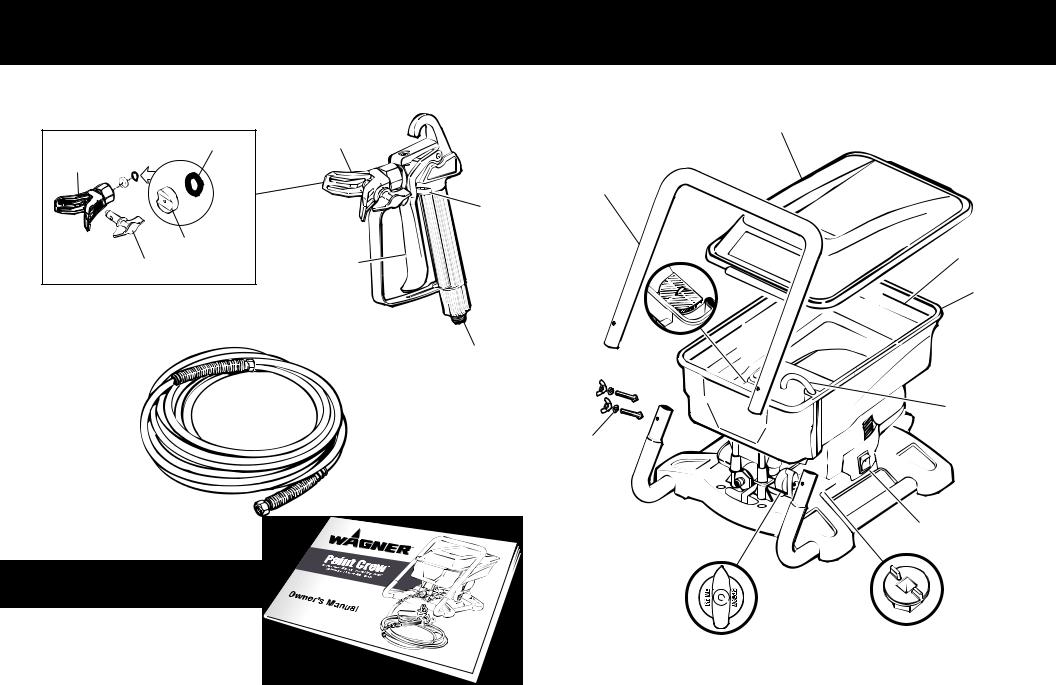
Before You Start
What’s in the Box?
Spray |
Washer* |
guard |
|
Saddle seat*
Spray tip
* Saddle seat and washer come pre-assembled inside spray guard
The Spray Gun
Spray Tip
Assembly
Trigger
The Paint Crew
Hopper Lid
|
Handle |
Trigger |
|
Lock |
Inlet |
|
|
|
Filter |
Spray Hose Fitting
Spray Hose
Handle
Hardware
Spray 
Hose
Outlet
Questions?
Call Wagner Technical Service |
|
1-800-328-8251 |
PRIME/SPRAY Knob |
Register your product online at:
www.wagnerspraytech.com
Fill Line
Hopper
Material
Return
Tube
ON/OFF Switch
Inlet Valve Tool
4 |
Before You Start • What’s in the Box? |
|
English |
||
|
|
|
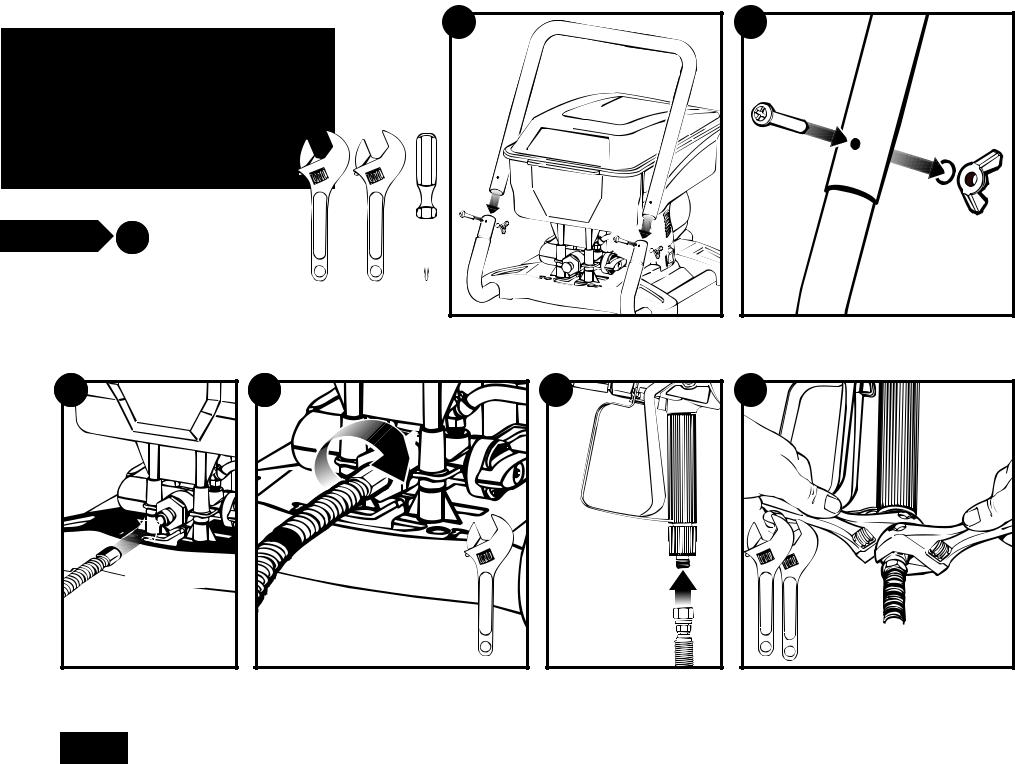
|
|
|
2 |
|
Assemble Your |
|
|
||
Wagner Paint |
|
|
||
Crew |
|
|
|
|
Start |
1 |
What you’ll need |
|
|
|
|
• Phillips screwdriver |
|
|
|
|
• Wrench (2) |
|
|
|
|
Note: Do not plug in the |
|
|
|
|
power cord until assembly is |
2. |
Insert handle |
|
|
complete. |
||
|
|
|
|
|
4 |
|
5 |
|
6 |

 TIGHTEN THREAD
TIGHTEN THREAD
THREAD
4. Thread one end of spray |
5. Tighten with wrench |
6. Thread other end of spray |
hose to outlet valve on sprayer |
|
hose to spray gun |
English |
|
Before You Start • Assemble Your Wagner Paint Crew |
Before You Start
3
3. On each side of the handle install bolt and tighten wing nut over lock washer
7
7. Hold spray gun with one wrench and tighten hose nut with other wrench
5
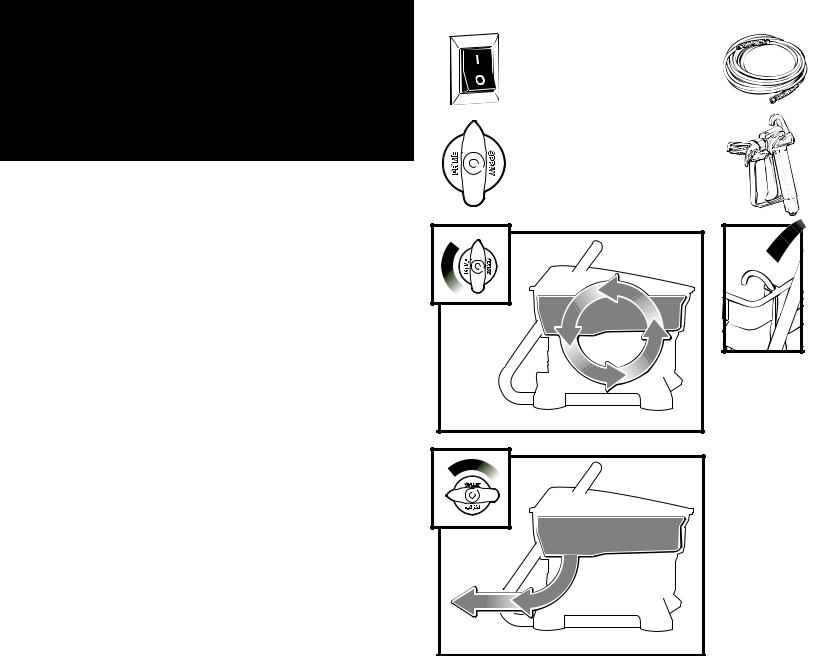
Using the Wagner Paint Crew
Proper Use and
Functions
Specifications
Weight |
25 lbs |
Capacity |
2 gallon hopper |
Power source ½ Hp universal motor
Power requirement 15 amp minimum circuit on
120 VAC, 60 Hz current
Generator 8000 Watt
Max. spraying pressure 2800 PSI
Controls and Functions
ON/OFF Switch: The ON/ OFF switch turns power
to sprayer on and off
(O=OFF,|=ON)
PRIME/SPRAY Knob: The
PRIME/SPRAY knob directs material to the material return tube when set to PRIME (figure
A) or to spray hose when set to
SPRAY (figure B)
PRIME |
Figure A. |
SPRAY |
Figure B.
Spray Hose: The spray hose connects the spray gun to the pump
Spray Gun: The spray gun controls the delivery of material being pumped
Material Return Tube:
Fluid is sent back out through
the return tube and into the hopper when the PRIME/
SPRAY knob is in the PRIME position
Capability
Sprays a variety of paints (oil-based and latex), primers, stains, preservatives and other nonabrasive materials. Do not use materials with flash points below 70° F (21° C)
Do not use!
This pump should not be used with textured materials, block filler, lacquers, industrial enamels, or asphalt sealer or materials containing HHC. See coating supplier if flash point is not listed on the container
Safety features
Spray gun trigger lock and pressure diffuser; builtin tip safety guard; PRIME/SPRAY knob for safe pressure release. Conforms to ULSTD 1450. Certified to CAN/CSAC 22.2 NO 68-92
6 |
Using the Wagner Paint Crew • Proper Use and Functions |
|
English |
||
|
|
|

Pressure Relief Procedure*
* Perform when instructed
Start |
1 What you’ll need |
Start |
• Waste bucket |
Using the Wagner Paint Crew
Important Safety Warning
Be careful when handling the spray gun so you don’t accidently spray yourself. The high pressure paint stream could pierce your skin causing serious injury. If an accident happens see detail procedures in the Safety Information section on pages 4-5. See physician immediately and bring this instruction manual.
Be sure to follow the Pressure Relief Procedure when shutting the unit off for any purpose. This procedure is used to relieve pressure from the spray hose. Failure to do so could result in serious injury.
2 |
K |
C |
O |
L |
2. Lock spray gun
3 |
4 |
|
|
|
N |
|
U |
R |
|
T |
|
OFF |
O |
|
|
|
|
3. Turn power OFF |
4. Turn knob to PRIME |
|
|
Using the Wagner Paint Crew • Pressure Relief Procedure |
English |
|
|
|
5
5. Unlock spray gun. Spray into a waste bucket until pressure is relieved. Lock the spray gun
7
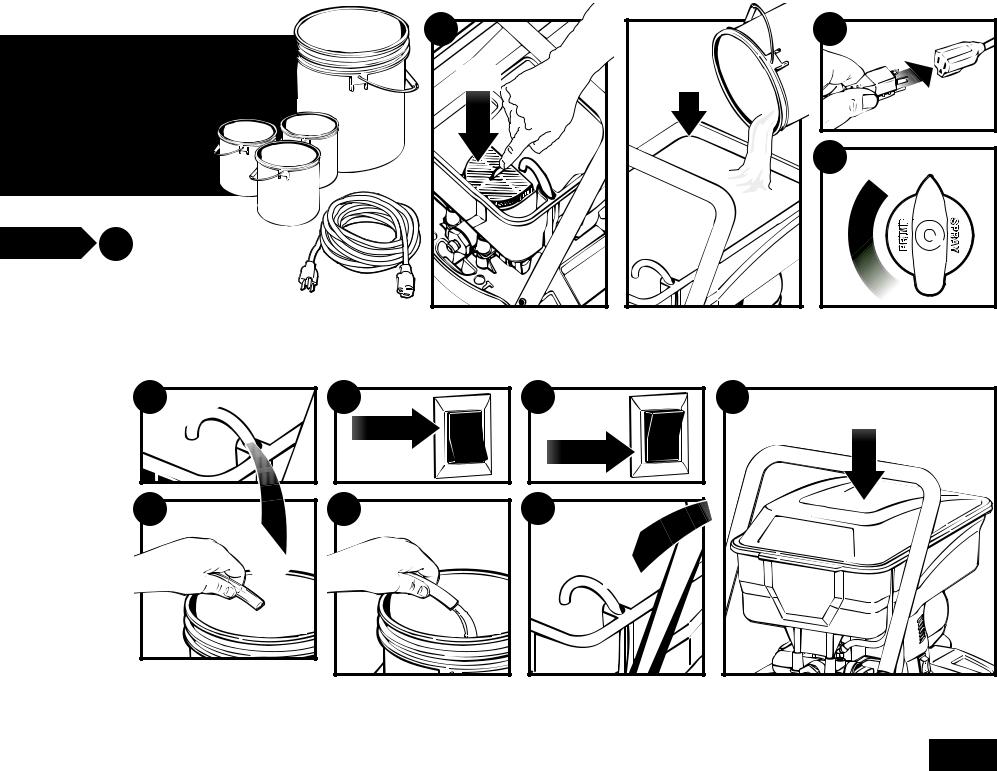
Using the Wagner Paint Crew
1. Load
Material
Start |
1 What you’ll need |
•The material you plan to spray
•Extension cord
•Waste container
2
PUSH
2. Push tab on filter twice to test inlet valve operation
FILL |
4 |
|
|
|
|
TO |
|
|
LINE |
|
|
|
5 |
|
|
|
N |
|
U |
R |
|
T |
|
3. Fill hopper TIP: If material |
4. Plug in sprayer |
|
is old, strain when pouring |
5. Turn knob to PRIME |
|
into hopper to help prevent |
|
|
clogging when spraying |
|
|
6 |
7 |
6.Remove material return tube from hopper
7.Hold tube over waste container
8
8 |
l |
|
ON |
||
|
||
9 |
|
8.Turn power ON
9.Steady flow for 5 seconds
10 |
|
|
|
|
|
|
OFF |
O |
|
|
|
|
|
|
|
|
|
11 |
|
|
|
|
E |
|
|
|
|
B |
|
|
|
|
U |
|
|
|
|
T |
|
|
|
|
|
E |
|
|
|
|
|
C |
|
|
|
|
|
A |
|
|
|
|
|
L |
|
|
|
|
|
P |
|
|
|
|
|
E |
|
|
|
|
|
R |
|
|
|
10.Turn power OFF
11.Snap return tube back in place
Using the Wagner Paint Crew • Load Material
12 |
HOPPER LID |
|
|
12. Place hopper lid on |
|
|
English |
